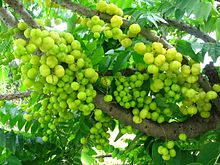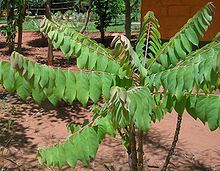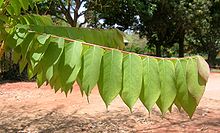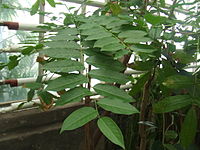- Phyllanthus acidus
-
Phyllanthus acidus fruits Scientific classification Kingdom: Plantae (unranked): Angiosperms (unranked): Eudicots (unranked): Rosids Order: Malpighiales Family: Phyllanthaceae Tribe: Phyllantheae Subtribe: Flueggeinae Genus: Phyllanthus Species: P. acidus Binomial name Phyllanthus acidus
(L.) Skeels[1]Synonyms Phyllanthus distichus Müll.Arg.
Cicca acida Merr.
Cicca disticha L.
Averrhoa acida L.Phyllanthus acidus, known as the Otaheite gooseberry, Malay gooseberry, Tahitian gooseberry, country gooseberry, star gooseberry, West India gooseberry, simply gooseberry tree, is one of the trees with edible small yellow berries fruit in the Phyllanthaceae family. Despite its name, the plant does not resemble the gooseberry, except for the acidity of its fruits. It is mostly cultivated for ornamentation.
Contents
Description
The plant is a an intermediary between shrubs and tree, reaching 2 to 9 m (6½ to 30 ft) high.[2] The tree's dense and bushy crown is composed of thickish, tough main branches, at the end of which are clusters of deciduous, greenish, 15-to-30-cm long branchlets. The branchlets bear alternate leaves that are ovate or lanceolate in form, with short petioles and pointed ends. The leaves are 2-7.5 cm long and thin, they are green and smooth on the upperside and blue-green on the underside. In general, the Otaheite gooseberry very much looks like the bilimbi tree.
The flowers can be male, female or hermaphrodite.[2] They are small and pinkish and appear in clusters in 5-to-12.5-cm long panicles. Flowers are formed at leafless parts of the main branches, at the upper part of the tree. The fruits are numerous, oblate, with 6 to 8 ribs, and densely clustered. They are pale yellow or white, waxy, crisp and juicy, and very sour. 4 to 6 seeds are contained in a stone at the center of each fruit.[2][3]
Origin and distribution
This tropical or subtropical species is found throughout Asia and also has a home in the Caribbean region, Central and South America.[4]
While its origin is uncertain, the species may have initially sprouted in Madagascar.[2][3][4] It was found in other parts of South Asia early; according to Eduardo Quisumbing, it was brought to the Philippines in prehistoric times.[2] It spread across the Indian Ocean to Réunion and Mauritius and crossed the Pacific to Hawaii.[2][3] It expanded to the Caribbean in 1793, when William Bligh carried the plant from Timor to Jamaica.[3]
The tree is common in Guam, Indonesia (where it is called ceremai or cerama), South Vietnam (called chùm ruột), Laos, northern Malaya (called cerme and chermai), and India (called chalmeri and harpharoi).[2][4] It is still found in the Philippines (called iba in Tagalog and karmay in Ilokano), if not widely, and in Cambodia (called kantuet) and Thailand (called mayom). In the United States, it is found in Hawaii and occasionally the southern parts of Florida.[2] It is seen in El Salvador, Mexico, Colombia, Venezuela, Surinam, Peru and Brazil.
Cultivation and human use
The Otaheite gooseberry prefers moist soil.[2] It can be cultivated in a variety of ways—budding, cutting and air-layering—in addition to the usual seed growth. The tree is cultivated for its ornamental value,[5] but also for food and medicinal purposes. While it produces some fruit throughout the year, it is mainly harvested in January except in South India, where it bears crops in April-May and again in August-September.[2] As the fruit does not soften when ripe, it is harvested when the fruit begins to drop.[6]
Various parts of the plant are used for food. In India and Indonesia, the cooked leaves are eaten.[3] While the fruit is eaten fresh, and is sometimes used as flavoring for other dishes in Indonesia, it is generally regarded as too tart to eat by itself in its natural form and is processed further.[3][4] It is candied in sugar or pickled in salt, used in chutney, relish or preserves. It is used to make vinegar in the Philippines and syrup in Malaysia. Liberally sugared, it is also used to make fruit juice.
The plant is also used medicinally. The peppered leaves are used to make a poultice to treat sciatica, lumbago and rheumatism, while the seeds are used as a cathartic and the root as a purgative.[4][7] The syrup is used to medicate the stomach, and in India the fruit is eaten as a blood-enhancer for the liver.[4]
While the wood is strong and durable if properly treated, the tree is rarely harvested for wood.[4] In India, the root bark is sometimes used for tanning.
References
- ^ "Phyllanthus acidus information from Catalogue of Life: 2011 Annual Checklist". Govaerts R. (ed). For a full list of reviewers see: http://apps.kew.org/wcsp/compilersReviewers.do (2011). WCSP: World Checklist of Selected Plant Families (version Dec 2010). In: Species 2000 & ITIS Catalogue of Life: 2011 Annual Checklist (Bisby F.A., Roskov Y.R., Orrell T.M., Nicolson D., Paglinawan L.E., Bailly N., Kirk P.M., Bourgoin T., Baillargeon G., Ouvrard D., eds). DVD; Species 2000: Reading, UK.. http://www.catalogueoflife.org/annual-checklist/2011/details/species/id/8171043. Retrieved 2011-05-04.
- ^ a b c d e f g h i j Center for New Crops & Plants Products. "Otaheite Gooseberry". Purdue University. http://www.hort.purdue.edu/newcrop/morton/otaheite_gooseberry.html. Retrieved 2011-10-30.
- ^ a b c d e f National Geographic (18 November 2008). Edible: an Illustrated Guide to the World's Food Plants. National Geographic Books. p. 110. ISBN 978-1-4262-0372-5. http://books.google.com/books?id=HORIzBx17DYC&pg=PA110. Retrieved 30 October 2011.
- ^ a b c d e f g Janick, Jules; Robert E. Paull (12 April 2008). The Encyclopedia of Fruit & Nuts. CABI. p. 373. ISBN 978-0-85199-638-7. http://books.google.com/books?id=cjHCoMQNkcgC&pg=PA373. Retrieved 30 October 2011.
- ^ Gupta, I. C.; S. K. Gupta (1 January 1992). Concept S Dictionary Of Agricultural Sciences. Concept Publishing Company. p. 346-347. ISBN 978-81-7022-301-6. http://books.google.com/books?id=TXmOcFArNDkC&pg=PA346. Retrieved 30 October 2011.
- ^ Morton, Julia (16 June 1963). "A Fast Growing Vine". The Miami News. http://news.google.com/newspapers?id=hZ8yAAAAIBAJ&sjid=C-oFAAAAIBAJ&pg=4461,397705&dq=otaheite+gooseberry&hl=en. Retrieved 30 October 2011.
- ^ Miller, Wilhelm (1901). Cyclopedia of American Horticulture. The Macmillan Company. p. 1318. http://books.google.com/books?id=F_0CAAAAYAAJ&pg=PA1318. Retrieved 30 October 2011.
Categories:- Phyllanthus
- Berries
- Flora of Southeast Asia
- Trees of the Caribbean
- Philippine ingredients
- Vietnamese ingredients
Wikimedia Foundation. 2010.





